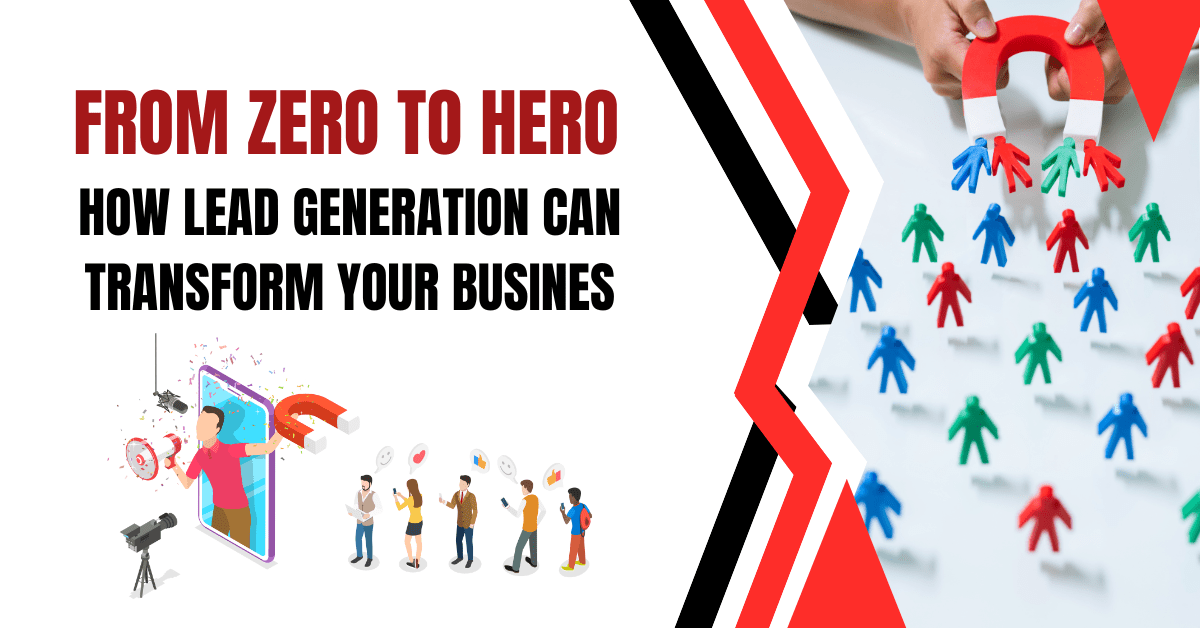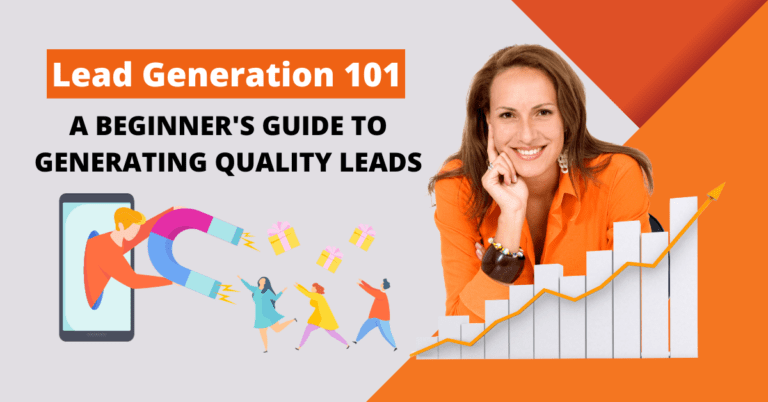Welcome to our ultimate guide to lead generation! Are you ready to take your business to new heights of success? Well, you’ve come to the right place. In this comprehensive guide, we will explore how lead generation can transform your business and provide you with actionable techniques and tools to get started. So, let’s dive in and unlock the tremendous potential that lead generation holds!
Benefits of Lead Generation
Before we delve into the techniques and tools, let’s first understand the immense benefits that lead generation can bring to your business. First and foremost, lead generation helps you increase the number of quality leads for your products or services. By adopting a targeted approach, you can attract prospects who are genuinely interested in what your business has to offer. This means higher conversion rates and ultimately increased sales opportunities.
Secondly, lead generation proves to be a cost-effective marketing strategy. Instead of relying solely on traditional marketing methods that are often expensive and yield uncertain results, lead generation allows you to find potential customers at a reduced cost per lead. This means you can achieve a higher return on investment (ROI) for your marketing efforts.
Lead Generation Techniques
Now that we understand the benefits, it’s time to explore the various lead generation techniques at your disposal. The following techniques have proven to be highly effective in attracting and nurturing leads:
Content Marketing
Content marketing has emerged as a powerful tool for generating leads. By creating valuable and engaging content, you can attract prospects and establish your business as an authority in your industry. This can be achieved through channels such as blogs, social media platforms, and video content. By consistently providing useful information, you can capture the attention of your target audience and increase the likelihood of converting them into leads.
Email Marketing
Email marketing remains an integral part of an effective lead generation strategy. Building an email list enables you to nurture leads and guide them through the buyer’s journey. By sending personalized and relevant emails, you can establish a relationship with your prospects and keep them engaged with your brand. Automation tools can further streamline the lead nurturing process, allowing you to save time and effort while maintaining a strong connection with your audience.
Search Engine Optimization (SEO)
With the vast majority of consumers turning to search engines to find information, it is crucial to optimize your website for search engine visibility. By targeting relevant keywords and optimizing your content, you can improve your website’s ranking in search results. Higher visibility translates to increased organic traffic and more opportunities to capture leads. Effective SEO tactics can ensure that your business is discovered by potential customers actively searching for solutions that you offer.
Social Media Marketing
Social media platforms offer immense potential for lead generation. By leveraging these platforms, you can reach and engage a wide audience. With features like targeted advertising, you can narrow down your focus to specific demographics, ensuring that your message reaches the right people. Engaging with your audience directly, running targeted ads, and implementing lead generation tools can significantly boost your lead capture efforts.
Lead Generation Tools and Technologies
Now that we have explored the different lead generation techniques, it’s time to take a look at the tools and technologies that can help you harness their power effectively:
CRM (Customer Relationship Management) Software: A CRM software is essential for managing and organizing your leads efficiently. It allows you to track lead interactions, monitor sales pipelines, and ensure that no opportunities slip through the cracks. With a CRM in place, you can stay organized and make informed decisions to boost your conversion rates.
Landing Page Builders: Landing pages play a crucial role in capturing leads’ information. With landing page builders, you can create attractive and high-converting landing pages without any coding knowledge. A/B testing and optimization features help you improve the effectiveness of your landing pages, resulting in higher lead generation and conversion rates.
Social Media Ad Platforms: Social media platforms, such as Facebook Ads and LinkedIn Ads, provide powerful advertising platforms for lead generation. These platforms enable you to target specific audiences based on demographics, interests, and behaviors. Monitoring your ad performance and fine-tuning your campaigns can ensure that you generate quality leads consistently.
Marketing automation platforms: These tools automate repetitive marketing tasks, such as sending follow-up emails or lead scoring. By setting up automated workflows, you can deliver personalized content to leads at specific stages of the customer journey, saving time and improving efficiency.
Lead tracking and analytics tools: These tools allow you to monitor the performance of your lead generation activities. By tracking metrics such as website visitors, click-through rates, and conversion rates, you can gain insights into the effectiveness of your campaigns and make data-driven decisions to optimize your lead generation strategies.
Integration with other marketing platforms: Integration with platforms such as social media management tools and email marketing software can streamline your lead generation efforts. By connecting different systems, you can track and manage your leads more efficiently, ultimately improving overall performance.
Effective Lead Generation Techniques
There are several effective techniques you can utilize to generate leads:
Content Marketing: Creating valuable and relevant content is a cornerstone of lead generation. By producing high-quality blog posts, articles, videos, and other forms of content, you can attract and engage your target audience. Content that addresses their pain points and provides solutions not only helps generate leads but also establishes your brand as an industry authority.
Social Media Marketing: Social media platforms provide excellent opportunities for lead generation. By sharing engaging content, running targeted ads, and interacting with your audience, you can attract potential customers to your website or landing pages. Social media platforms also offer various tools for lead capturing, such as lead forms and chatbots.
Email Marketing: Email campaigns remain a highly effective lead generation tool. By building an email list of interested individuals, you can directly nurture leads by sending them relevant content, promotions, and exclusive offers. Personalization and automation can further enhance the effectiveness of your email marketing efforts.
Search Engine Optimization (SEO): Optimizing your website for search engines helps improve its visibility and organic traffic. By targeting relevant keywords, creating valuable content, and optimizing your website’s structure and meta tags, you can attract potential customers who are actively searching for solutions that your business offers.
Lead Generation Best Practices
To maximize the effectiveness of your lead generation efforts, consider these best practices:
Creating compelling and optimized landing pages: A well-designed landing page with a clear call to action (CTA) is crucial for converting visitors into leads. Optimize your landing pages by focusing on a single offering, using persuasive copy, and minimizing distractions.
A/B testing and optimizing lead capture forms: Experiment with different variations of your lead capture forms to understand what resonates with your audience. Test different headlines, form lengths, and form fields to find the optimal balance between gathering necessary information and reducing friction in the lead capture process.
Personalization and segmentation for better targeting: Tailor your content and communications to the specific needs and interests of your leads. By segmenting your leads based on demographics, behavior, or preferences, you can deliver highly personalized experiences that resonate with them and increase conversion rates.
Continuous improvement through monitoring and analysis: Regularly monitor and analyze your lead generation metrics to identify areas that need improvement. Measure the effectiveness of different tactics, track your lead-to-customer conversion rates, and optimize your strategies accordingly.
Case Studies: Real-Life Business Transformations
To further illustrate the power of lead generation, let’s examine a couple of real-life case studies:
Example 1: XYZ Company
XYZ Company implemented lead generation strategies and experienced a remarkable 50% increase in their customer base. By adopting targeted approaches like content marketing and email campaigns, the company attracted high-quality leads and achieved impressive conversion rates. This success showcased the potential of lead generation techniques in driving business growth.
Example 2: ABC Startup
ABC Startup, a small player in the market, effectively utilized lead generation efforts to establish its presence and compete with larger competitors. Through a combination of SEO tactics, social media marketing, and targeted ads, they were able to generate a steady stream of leads. The company’s success story highlights how lead generation can level the playing field for businesses of all sizes.
Overcoming Challenges in Lead Generation
While lead generation can be immensely beneficial, it comes with its own set of challenges:
Identifying common obstacles, such as low website traffic, low conversion rates, or difficulty in accurately measuring ROI, is the first step towards overcoming them. By staying up to date with the latest marketing trends and consumer behavior, you can adapt your lead generation strategies accordingly. Regularly reviewing and optimizing your campaigns is essential to maintain continuous improvement.
How Lead Generation Can Transform Your Business?
Lead generation offers numerous benefits that can transform your business:
Increasing brand awareness and visibility: By reaching out to potential customers through various marketing channels, lead generation helps increase brand recognition. When your target audience becomes more familiar with your brand, they are more likely to consider your offerings when making purchase decisions.
Improving customer acquisition and conversion rates: Lead generation activities enable you to attract and capture interested individuals, increasing the likelihood of turning them into paying customers. By nurturing leads through personalized and relevant content, you can guide them through the customer journey, ultimately improving your conversion rates.
Enhancing customer retention and loyalty: Lead generation doesn’t end once a lead converts into a customer. By consistently engaging and nurturing your customer base, you can foster loyalty and encourage repeat purchases. Maintaining relationships with existing customers is more cost-effective compared to acquiring new ones, making lead generation an essential aspect of customer retention strategies.
Conclusion
Now that you understand the power of lead generation and the techniques and tools available to you, it’s time to take action and transform your business. By implementing these strategies and leveraging the right tools, you can capture quality leads, increase your sales, and propel your business to new heights of success. Get started today, and watch your business flourish!
Now that you have a comprehensive understanding of how lead generation can transform your business, it’s time to put it into action. By utilizing the right techniques and tools, you can attract and nurture quality leads, increase sales, and take your business to new heights. So don’t wait any longer, start implementing lead generation strategies today and watch your business flourish!
Thank you for reading! Share your experiences and questions in the comments below!



